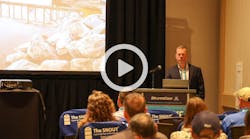Retaining Walls: What You See and What You Don’t – Part 3
Three Key Principles
Clint Ernst cites three key principles for retaining wall construction:
- A good base
- Good compact backfill
- Good drainage throughout the wall
The entire wall has to be a big drain, he says, so that any individual piece of wall can serve at some time as a drainage point.
“On large projects, engineers and contractors should always know how water moves across neighboring properties and how this runoff will affect their client’s project,” Clint notes. “In addition to rain runoff, all nearby springs—even long-buried springs—and the course of their runoff should be identified. With springs, installing plenty of drain tiles and rocks to avoid water retention and drainage problems is important.“We always recommend that our clients hire a certified engineer, who hopefully will see the site before designing their projects. Anyone can design a wall you’d like to see built, but it takes an expert to consider soil patterns, runoff, and how much geogrid is required. Understanding the land’s previous use also is important, especially what might be buried on the site.”
Correcting Failed Projects
Custom Retaining Walls is sometimes called to correct failed retaining wall projects. On one occasion, the contractor for a new office-warehouse complex in Rochester installed several hundred linear feet of a 20-foot-tall modular wall.
“They neither hired an engineer nor followed my recommendations,” says Clint. “They did not install enough geogrid and used nonengineered fill [fill of unknown origin]. The first winter, the wall failed.
“The owner asked us to fix the wall. First we hired an engineer. Then we told them we were going to take down the entire wall and rebuild using Rockwood products. Very little could be salvaged.”
New construction started from scratch. All of the fill was removed. The site was taken back to grade rock…3–4 feet underground.
“Following the engineer’s direction, we built a good base, compacting each level as we built the wall. The project cost the client twice what it should have” because it had to be rebuilt, he says. “Good product was used in the original wall, but the installation was wrong.”
strong>A “Landscaped” Appearance
Appearance of a retaining wall is important on many projects. Vinci Pacific Corporation, a general engineering contractor in Del Mar, CA, was the subcontractor for DPR Construction on construction of a new facility for Pfizer Inc. in the Torrey Pines area of San Diego. “We excavated the basement of one building to connect to a new building, and we had to build a retaining wall to extend the back of the building overlooking a canyon,” explains Sean Christiansen, project manager and estimator for Vinci Pacific.
Vinci Pacific used a “plantable” segmental wall system from Soil Retention Products Inc. “The system is quick to install and is 100% landscape,” says Christiansen. “Some people don’t like to look at concrete. You may have the appearance of a steep slope, but because of the vegetation, you can no longer see the concrete.” Common plantings in such walls include ivy and rosemary.
Soil Retention Products is owned by Jan Janssen, who also owns Soil Retention Systems Inc., a segmental retaining wall installation company, and Toy Rentals Inc., which rents and sells special equipment for block production and retaining wall installations.
Solutions for Site Development Challenges
Site development using “engineered systems” solutions is a specialty of Tensar Earth Technologies Inc. (TET), an Atlanta, GA – based company that offers several earth retaining wall, steepened slope, roadway soil reinforcement, and foundation stability applications to solve geotechnical problems in the development of difficult sites.
Since its inception in the 1980s, TET has worked on more than 25,000 projects worldwide, says Peter E. Larkin, P.E., the firm’s business development manager. The parent company of TET, The Tensar Corporation, develops and manufactures high-performance, soil-reinforcement polymeric structural geogrids, which TET sells as components of its engineered systems. Tensar geogrids, made of high-density polyethylene and polypropylene, are designed on a site-specific basis to provide the tensile strength and length of service required for each application.
TET generates much of its business in working closely with various state departments of transportation (DOT), local departments of public works, and general contractors and subcontractors bidding on projects in the public DOT and private marketplace. “We provide our clients with complete systems design, construction materials supply, and onsite start-up technical assistance,” says Larkin. “The challenges faced today by designers and developers are greater than ever before, as the cost associated with site development increases. The sites that are easy to develop are all but nonexistent, and owners and investors demand economical solutions for complex engineering challenges.”


